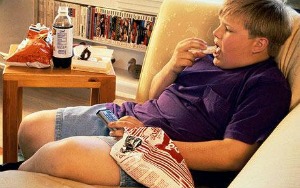Food and Childhood Obesity
While a poor diet can cause various deficiencies, conversely excessive caloric intake causes overweight in children, then this in most cases leads to obesity.
The hyper-feeding during the first two years of the child, causes an increase in the volume of the fat cells, will also make it much more difficult to lose weight as adult or simply keep it in normal boundaries.
Inactivity and Childhood Obesity
In addition to poor diet, the lack of physical activity and overall inactivity are risk factors, that should not be overlooked. Children are indeed often accompanied to school with a car, they take the elevator to go up even to the first floor, and spend hours in front of the TV or computer, and many other bad habits and practices .
Genetic Factors in Childhood Obesity
Many family related factors are also considered in childhood obesity. Obesity, in some aspects, can be considered as a hereditary disease and is a result of many environmental factors.
Indeed, the example of the parents is fundamental: we can not talk about food education if the parents themselves do not follow a balanced diet. As regards the nature of hereditary obesity, alterations of some genes with a role in the production of fat cells, have been determined, but the studies are still in progress.
Although many measures have been taken in recent years in in western world and the United States for reduction of childhood obesity, it still remains a real public health problem. This is why it’s extremely important to inform the people how to preventing obesity, including adopting good practices to limit the phenomenon.
It is not recommended that children to be put on a diet or restrict their calorie intake this could affect their growth and create other health problems. Talk to your child’s doctor to come up with a safe and effective plan.
The best treatment is to improve their nutrition plan and increase the physical activity as early as possible to ensure that children will adopt habits that will become part of their lifestyle.
The Diagnosis of Obesity
The diagnosis of obesity is usually based on a medical examination and patient history (such as eating habits and physical activity.) Children are considered “medically obese”, when their weight poses a risk to their health. The degree of obesity is often measured using the body mass index (BMI.) BMI is calculated by the following formula:
BMI = body weight (kg) ÷ height ² (m)

For Example: if your 4 year old son weighs 40 lbs, which is equivalent to 18 kg and is measuring 38 inches which is equal to 95 cm or 0.95 m, you will have to divide 18 by (0.95 × 0.95). The result is 19.9. We are using kilograms (kg) and meters (m) for this calculation, because they are the standard measures.
Bellow is given a growth chart that uses the BMI number which is referred to as a percentile, based on a child’s sex and age. The percentiles are then used to determine the different weight groups:
- Underweight: less than the 5th percentile
- Normal weight: 5th percentile to less than the 85th percentile
- Overweight: 85th percentile to less than the 95th percentile
- Obese: 95th percentile or higher
Normal BMI values differ for boys and girls of different ages. If the weight of your child worries you, check with your doctor or health care professional who will compare the BMI of your child to a standard growth chart and will tell you if the child is in need of treatment to lose weight.
Treatment for Obesity
All children should undergo a medical examination before beginning a weight loss treatment. The goals of the treatment are:
- Losing weight slowly (eg, about 0.5 kg or 1 lb per month).
- Maintaining normal growth in children (eg, continuing to grow normally) without gaining excess weight.
- Modifying the diet, physical activity and behavior.
- Involvement of the family in the process thru consultation and support.
- Avoid regaining of the weight that your child already lost.
Recent research shows that diet, physical activity and behavior modification are more effective when the whole family is involved. A program of weight loss can be harmful and futile if the family is not ready to make the necessary changes, as non successful attempts may further lower self-esteem in children.
Family support is an important component of the treatment and more “parental” principles should be applied to correct eating habits and physical activity. This can be done with the following:
- Find reasons to praise your child’s behavior, when it is correct.
- Offer rewards for positive behavior and habits change. Never offer food as a reward.
- Establish regular times for meals and snacks.
- Determine what foods are available and when. Let your child decide whether to eat or not.
- Offer only healthy food choices.
- Remove unnecessary temptations.
- You should serve as a good example to your child.
- Be constant in your efforts.
Drugs and surgery are sometimes used to treat obesity in adults. These options should be avoided because they are not recommended routinely in children and are usually never considered, unless obesity is becoming a threat for the life of the child.
What are the recommended habits that have to be adopted?
- Limit the consumption of sugary drinks and nibbling sweets or fatty foods. Instead, offer them water for a drink and teach them to eat a balanced food.
- Prefer vegetables and fruits over cooked dishes, grilling or steaming is preferable and is healthy, contrary to frying with different type of fats (oil, butter, margarine).
- Encourage physical activity (cycling, walking, football … etc.) instead of spending their time watching television, computer or video games.
- Give them a good example by eating healthily and exercising regularly.
Qualitative recommendations remain relevant in keeping a balanced diet. Parents have to ensure that they give a balanced diet to their children from an early age:
- Continue breastfeeding until your baby is at least 6 months old or longer
- Food diversification should be practiced after the age of 6 months with the introduction of fruits, vegetables and protein
- Reasonable intake of complex carbohydrates (bread, starchy products…) and limiting those that may contain hidden fats
- Limit fatty meats, meats, prepared foods, fatty cheeses
- Add regular milk and dairy in the child’s meals or in moderation
- Make sure and give your child enough water to drink and ban sugary drinks or beverages
- Introduce your child to a regular breakfast, which should represent 25% of the dietary intake
- Avoid snacking between meals or at least limit them as much as possible, if there is a feel of urgent hunger try to overcome it by taking a fruit or some light low fat dairy product
- Slow chewing is very important for maintaining a stable general health, also take normal portions and eat meals in a quiet and friendly atmosphere
- Promote the learning of new (healthy) flavors or foods to your kids such as fruits and vegetables
Of course, sometimes herbal medicine, organotherapy, gemmotherapy can be used in order to accelerate the burning of the body fat and to reduce appetite.
In conclusion, it can be said that if you comply with the recommendations mentioned above, you will be able with a great success to keep your children away from overweight and obesity, maintaining in the same time not only their overall health but also yours. Ensuring that way a happier and full life for your family.
Guest Post Author’s bio:
 Jessy Donston is a software engineering student, a SEO expert and healthy life enthusiast, which is passionate about educating himself and others on everything and mostly on health. He is always searching and collecting every available information about health, nutrition, diets, fitness, healthy lifestyle and healthy food. Jessy also have very deep interest in science and technology researches and enjoys his role as the administrator and editor of his blog ( you would maybe call him a geek and he wouldn’t mind much :)). You may see him sometimes jogging, biking or doing some other sport in his home town Newport, England. As a dedicated and inspired blogger he is constantly trying to help everybody that may need any kind of help and that is actually the reason why he started his blogging adventure with his blog at: www.domehealth.com.
Jessy Donston is a software engineering student, a SEO expert and healthy life enthusiast, which is passionate about educating himself and others on everything and mostly on health. He is always searching and collecting every available information about health, nutrition, diets, fitness, healthy lifestyle and healthy food. Jessy also have very deep interest in science and technology researches and enjoys his role as the administrator and editor of his blog ( you would maybe call him a geek and he wouldn’t mind much :)). You may see him sometimes jogging, biking or doing some other sport in his home town Newport, England. As a dedicated and inspired blogger he is constantly trying to help everybody that may need any kind of help and that is actually the reason why he started his blogging adventure with his blog at: www.domehealth.com.
Credit for Image sources:
Top Photo – Image source: wellness.nysbs.com
Obesity Complications – Image credit: obesityhelp.com
Do you offer your children healthy options at meal time?

Comments
6 responses to “Childhood Obesity – Causes, Diagnosis and Treatment”
this is so sad… and it is so common for children nowadays..
I am glad that schools have stepped up their nutrition and are now providing children with healthier alternatives. Also, they have added some time for kids to get a little bit of exercise. Of course, I wish schools were able to provide a bit more because some parents aren’t pushing their kids to be active at home.
This is so very sad. My niece is overweight and she has a large gut that actually sticks over her pants. Her father is diabetic. So you would think they would be more concerned about her diet. And if you try to tell the parents she is overweight they say that their doctor says that she is not. WTF.
I feel bad for children whose parents out to know better and set their kids off to a better start so that they aren’t obese their entire life.
Article contains so many fruitful information which will be liked by the readers as in my opinion this is the best article in this category.
[…] services, Coco-Cola and Anthem Foundation. Together they are aiming to combat the growing rate of childhood obesity among our nation’s youth. Since launching this program in 2005, Triple Play has made close to 10 […]